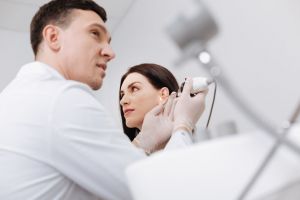Single-sided deafness (SSD) is a condition in which a person has lost hearing in one ear, but can still hear with the other ear. It’s also known as unilateral hearing loss.

single-sided deafness, also known as
unilateral hearing loss.
We were designed to have two ears for a reason—the brain uses both ears to pinpoint the location of a sound, and to improve hearing quality and range. This is known as binaural hearing.
How it affects hearing
Losing hearing in one ear presents unique challenges:
- You can’t always pinpoint where a sound is coming from: Your brain knows where a sound is coming from by which ear receives the sound first, known as sound localization or directional hearing. When a person can only hear from one ear, he or she may have difficulty figuring out where the sound originated.
- You may struggle to hear in noisy environments: Your brain is in charge of selective listening, meaning, filtering out noises that aren’t useful. This is tougher to do without the aid of a second ear. In a noisy environment, a person with SSD can struggle to focus on a single person’s voice.
- You may have a harder time telling how loud a sound is: The brain “hears” a sound more loudly when it’s perceived through both ears than if the same sound at the same decibel were only perceived through one ear. This is because the brain receives signals from the nerves located in both ears and uses this information to process sounds.
- You may struggle to multi-task: Because of all of the above, single-sided deafness increases cognitive load on the brain. The more noise there is, the longer it takes your brain to focus on the tasks at hand. If you’re also trying to listen to someone speak, you may miss a significant amount of what is being said.
The ‘head shadow’ effect
If you have unilateral hearing loss, you will likely experience something known as the “head shadow” effect. Due to the way sound waves travel, high-frequency sounds don’t “bend” around to the side of the functional ear, meaning a person never hears them.
“The head essentially acts as a shield, blocking sounds from the poorer hearing ear from reaching the better hearing ear,” explained Cleveland Clinic audiologist Sarah Sydlowski, in an online discussion with patients.
The end result is that speech can sound muffled, because a person can’t hear high-frequency sounds like “s” or “f.”
Causes of unilateral hearing loss
There are a number of potential causes of SSD, including but not limited to:
- Meniere’s disease
- physical damage to the ear
- head trauma
- acoustic neuroma
- viral or bacterial infection
- circulatory system disorders
Sometimes a cause can’t be identified, or is due to a combination of factors.
Single-sided deafness can develop quickly—you should always act fast if you or a loved one experiences sudden hearing loss. The quicker you seek treatment, the better your chances are for a full recovery. When hearing can’t be fixed with medical treatment, single-sided deafness is often the result, which happens about 15% of the time.
Treatment options for single-sided deafness
SSD is often permanent, but sometimes treatable with devices worn on your functioning ear. Your audiologist will perform a hearing test, and ask you questions to try and identify the cause of your hearing loss. From there, he or she might recommend a CROS, BiCROS, or bone-anchoerd hearing system:
Contralateral routing of sound (CROS) system
A CROS system is designed for people with near-total hearing loss in one ear, but normal hearing in the other. A CROS detects the sounds occurring on the deaf ear, and routes them to the good ear. This requires wearing a device on each ear: On the non-functional ear, the person wears a transmitter device, and in the functional ear, the person wears a receiver that processes the sound and delivers it via a microphone. This sound is not amplified beyond normal because the person has relatively normal hearing.
BiCROS hearing aids work the same way, except they’re designed for people whose functional ear has moderate-to-severe hearing loss. This means the functional ear not only receives sound from the transmitter on the other ear, it is also receives amplified sound via a typical hearing aid. Several different manufacturers make CROS and BiCROS hearing aids.
It’s important for patients to realize these devices re-route sound, but do not “restore” hearing to the deaf ear, according to Erika Woodson, MD, Medical Director of Cleveland Clinic’s Hearing Implant Program, in an online discussion with patients about the devices. “You will not hear in stereo. The benefits of these hearing strategies are to improve awareness of sound from 360 degrees, but you will not be able to localize sound.”
Bone-anchored hearing systems
Some people do not find CROS hearing aids helpful. An alternative is a bone-anchored hearing system, which requires surgical implantation. These devices, also known as bone-anchored auditory implants, send sound vibration directly to the inner ear through the skull bone, a process known as bone conduction. This can be helpful because middle ear and ear canal problems might prevent sound waves and signals from reaching the inner ear. In those cases, standard hearing aids are ineffective.
Cochlear implants work by directly stimulating the auditory nerve. They are not normally used for single-sided deafness, though some researchers are exploring the idea.
For more information
If you are interested in learning more about whether you might be a good candidate for a CROS hearing aid or a bone-anchored hearing system, talk to an ENT physician or an audiologist in your area.
